Binary packing and encryption are essential for protecting software from reverse engineering and securing sensitive data. Whether you're developing Android apps, Java programs, or securing files and drives, choosing the right tool depends on your specific needs. Here's a quick overview of the top tools:
- ProGuard: Shrinks and obfuscates Java and Android apps to protect code.
- R8: Google's default Android code shrinker, replacing ProGuard for newer projects.
- AndResGuard: Focuses on reducing APK size by optimizing resource files.
- yGuard: Obfuscates Java bytecode across platforms, ideal for enterprise applications.
- JShrink: Optimizes Java applications with dead code elimination.
- MidgetPack: Compresses and obfuscates ELF binaries for Linux and FreeBSD.
- Burneye: Offers basic binary protection for Linux ELF files.
- VeraCrypt: Encrypts files, partitions, or drives for secure data storage.
- BitLocker: Built-in Windows tool for full-disk encryption.
- AxCrypt Premium: Encrypts individual files with AES-256, suitable for small businesses.
- NordLocker: Encrypts and organizes files in secure lockers with cloud integration.
- 7-Zip: Combines file compression and AES-256 encryption for secure archiving.
These tools help safeguard applications and data, each offering distinct features for specific use cases, from Android development to full-disk encryption. Below is a quick comparison of their primary uses, platform support, and licensing.
Quick Comparison
| Tool | Primary Use | Platform Support | License Type |
|---|---|---|---|
| ProGuard | Code shrinking/obfuscation | Android, Java | Open-source |
| R8 | Android code optimization | Android | Open-source |
| AndResGuard | Resource file compression | Android | Open-source |
| yGuard | Java bytecode obfuscation | Java (cross-platform) | Open-source |
| JShrink | Java optimization | Java | Open-source |
| MidgetPack | ELF binary compression/packing | Linux, FreeBSD | Open-source |
| Burneye | Binary protection | Linux | Open-source |
| VeraCrypt | File/drive encryption | Windows, macOS, Linux | Open-source |
| BitLocker | Full-disk encryption | Windows | Proprietary |
| AxCrypt Premium | File-level encryption | Windows, macOS, Mobile | Proprietary |
| NordLocker | Cloud-based file encryption | Windows, macOS, Mobile | Proprietary |
| 7-Zip | File compression/encryption | Windows, Linux, macOS | Open-source |
Each tool offers unique benefits, from reducing app sizes to securing sensitive data. Choose based on your project requirements, platform, and desired level of protection.
What is Software Packing and Code Obfuscation?
1. ProGuard
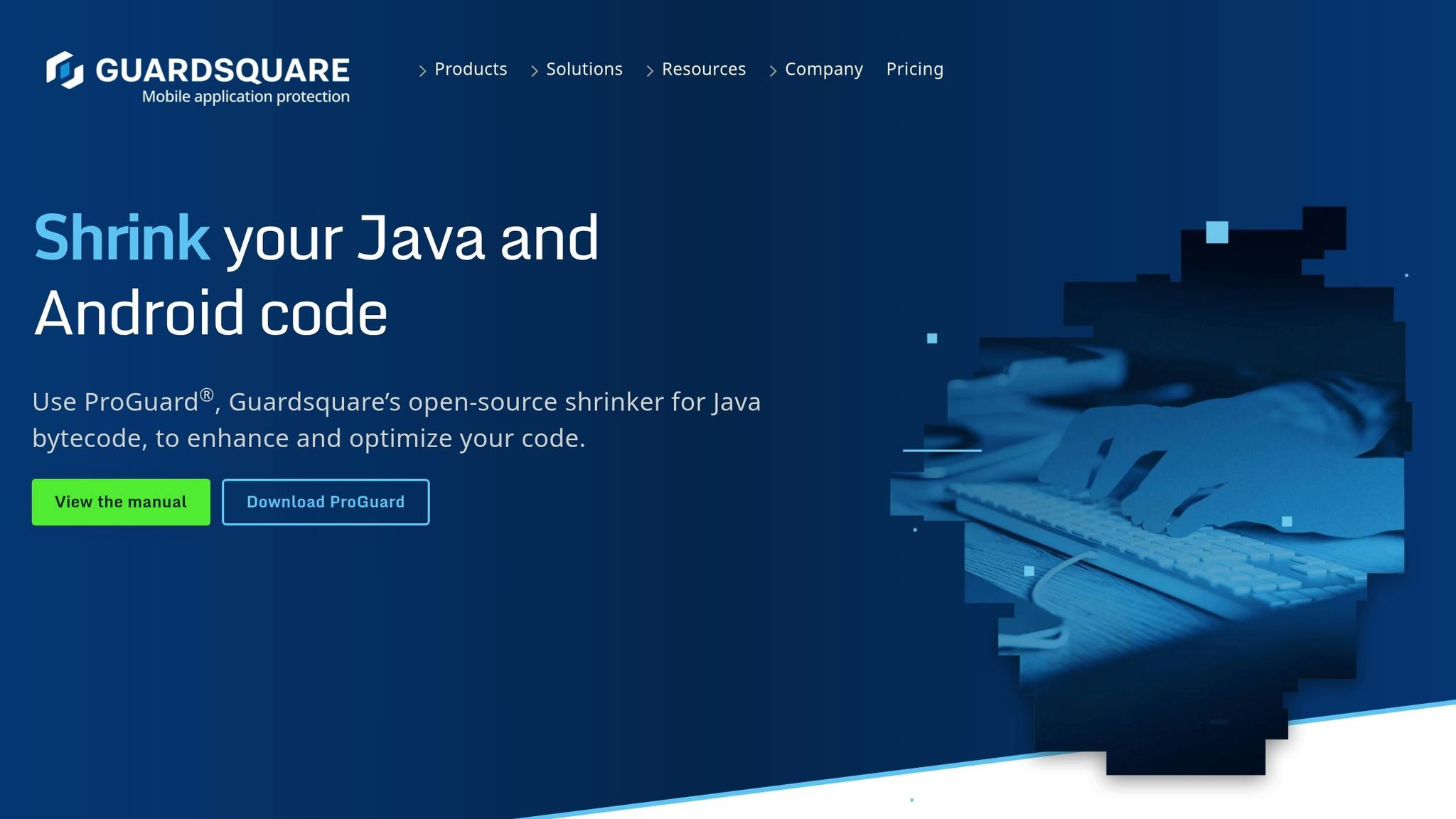
ProGuard is a powerful tool for improving Java applications through code shrinking, optimization, and obfuscation. It's an open-source command-line utility that integrates smoothly into development workflows, making it a reliable choice for developers.
Platform Support
ProGuard is designed to optimize Java bytecode, making it suitable for a variety of platforms. While it's widely used in Android development - being bundled with the Android SDK and Android Studio - it also works with J2SE and JME midlets. Developers can specify the runtime JAR for compatibility across these environments. For Android-specific projects, ProGuard includes a -android option that tailors optimizations to the Android platform, ensuring it works seamlessly with the system's unique requirements. This adaptability makes it a go-to tool for Java developers working across different environments.
Open-Source Benefits
As an open-source tool licensed under GNU GPL v2.0, ProGuard offers flexibility without impacting the licensing of your proprietary code.
"ProGuard itself is distributed under the GPL, but this doesn't affect the programs that you process. Your code remains yours, and its license can remain the same."
This ensures that developers can use ProGuard in their workflows without worrying about licensing conflicts.
Primary Use Case
ProGuard is particularly effective for shrinking and obfuscating code, making it harder for attackers to reverse engineer applications. Instead of encrypting code, it renames identifiers in Java class files, adding a layer of protection.
"Android applications are easy targets for reverse engineering which makes it essential for developers to deploy ProGuard as a basic security measure. A built-in tool in the SDK, ProGuard is an effective way to guard your app's codebase with minimal configurations."
It also supports class file verification for specific Java versions, such as Java 6 and Java Micro Edition, which helps optimize apps for targeted environments.
Performance Impact
ProGuard contributes to smaller and faster applications. By shrinking and optimizing code, it can reduce app size by about 8.5%. This not only speeds up downloads but also improves runtime performance. However, while ProGuard offers basic obfuscation, it's not a comprehensive security solution for defending against advanced reverse engineering techniques. Its primary strength lies in optimization and size reduction rather than full-scale security.
2. R8
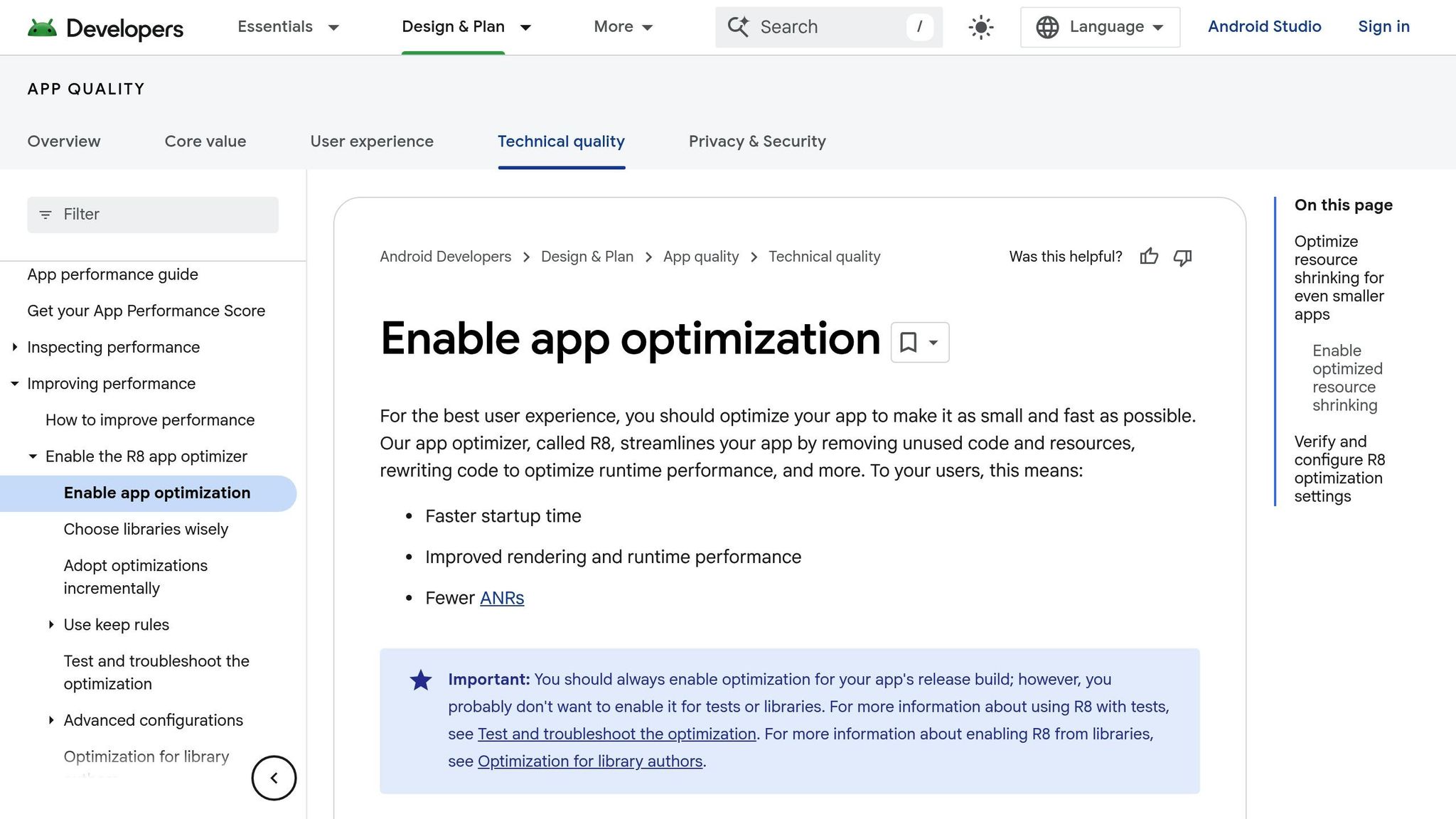
R8 is Google's advanced tool for shrinking, optimizing, and obfuscating Java bytecode in Android applications. It serves as the successor to ProGuard, offering a more refined and automated approach to code optimization within the Android build process.
Platform Support
R8 is specifically tailored for Android apps, working to optimize Java bytecode for Android runtime environments. Starting with Android Gradle Plugin (AGP) version 3.4.0, R8 became the default code shrinker, seamlessly integrating into the Android build workflow. This means most modern Android projects automatically take advantage of its features. For developers using AGP 9.0.0 or later, enabling isShrinkResources = true also triggers automatic resource shrinking, further enhancing app efficiency. This built-in functionality simplifies the development process and ensures optimized builds.
Primary Use Case
R8's primary role is to compress and obfuscate Android app code. It removes unused code and resources, helping to streamline applications and improve runtime performance.
"R8 is an advanced code shrinker and obfuscator designed for Android applications."
- Jaykishan Sewak
Performance Impact
R8 significantly reduces app size and boosts runtime performance. By eliminating unnecessary code and resources, it creates smaller APK files, which not only load faster but also perform better on Android devices. Thanks to its tight integration with the Android build system, these optimizations happen automatically during the build process, ensuring the final app is efficient and well-optimized.
3. AndResGuard

AndResGuard, created by the WeChat team, is a tool designed to shrink Android APK sizes by focusing on resource files. While traditional code obfuscators typically deal with source code, AndResGuard takes a different route by targeting resource optimization, making it an essential tool for Android developers.
Open-Source or Proprietary
Released under the Apache-2.0 license, AndResGuard is an open-source tool. This licensing not only allows developers to use it freely but also gives them the freedom to modify and distribute it. Its open-source nature has helped it gain traction within the Android development world.
Platform Support
AndResGuard operates as a command-line tool and is compatible with Windows, Linux, and macOS. Its sole focus on optimizing Android APK files enables it to offer features tailored specifically for resource management - features that more generalized tools may lack.
Primary Use Case
The main function of AndResGuard is to obfuscate and compress Android resource files. It achieves this by renaming file paths and names to shorter alternatives. For example, a file path like res/drawable/wechat can be transformed into r/d/a, and a file such as wechat.png might become a.png. This process significantly reduces the APK size.
"AndResGuard is a tooling for reducing your apk size, it works like the
ProGuardfor Java source code, but only aim at the resource files."
- shwenzhang/AndResGuard GitHub
Additionally, it trims down the size of the resources.arsc file and offers the option to repackage APKs using 7zip for further compression. Beyond reducing file size, this also makes the APK more challenging to reverse-engineer with tools like Apktool.
Performance Impact
AndResGuard is designed to process APKs efficiently and does not require access to the source code. However, enabling 7zip compression can interfere with Google's file-by-file patching system for app updates on the Play Store.
"Do NOT enable 7zip compression(
use7zip) when you distribute your APP on Google Play. It'll prevent the file-by-file patch when updating your APP."
- shwenzhang/AndResGuard GitHub
For developers planning to distribute apps via the Google Play Store, it’s best to use AndResGuard’s resource obfuscation features without enabling 7zip compression. This ensures that incremental updates remain functional. Up next, we’ll take a closer look at yGuard and its approach to code obfuscation.
4. yGuard
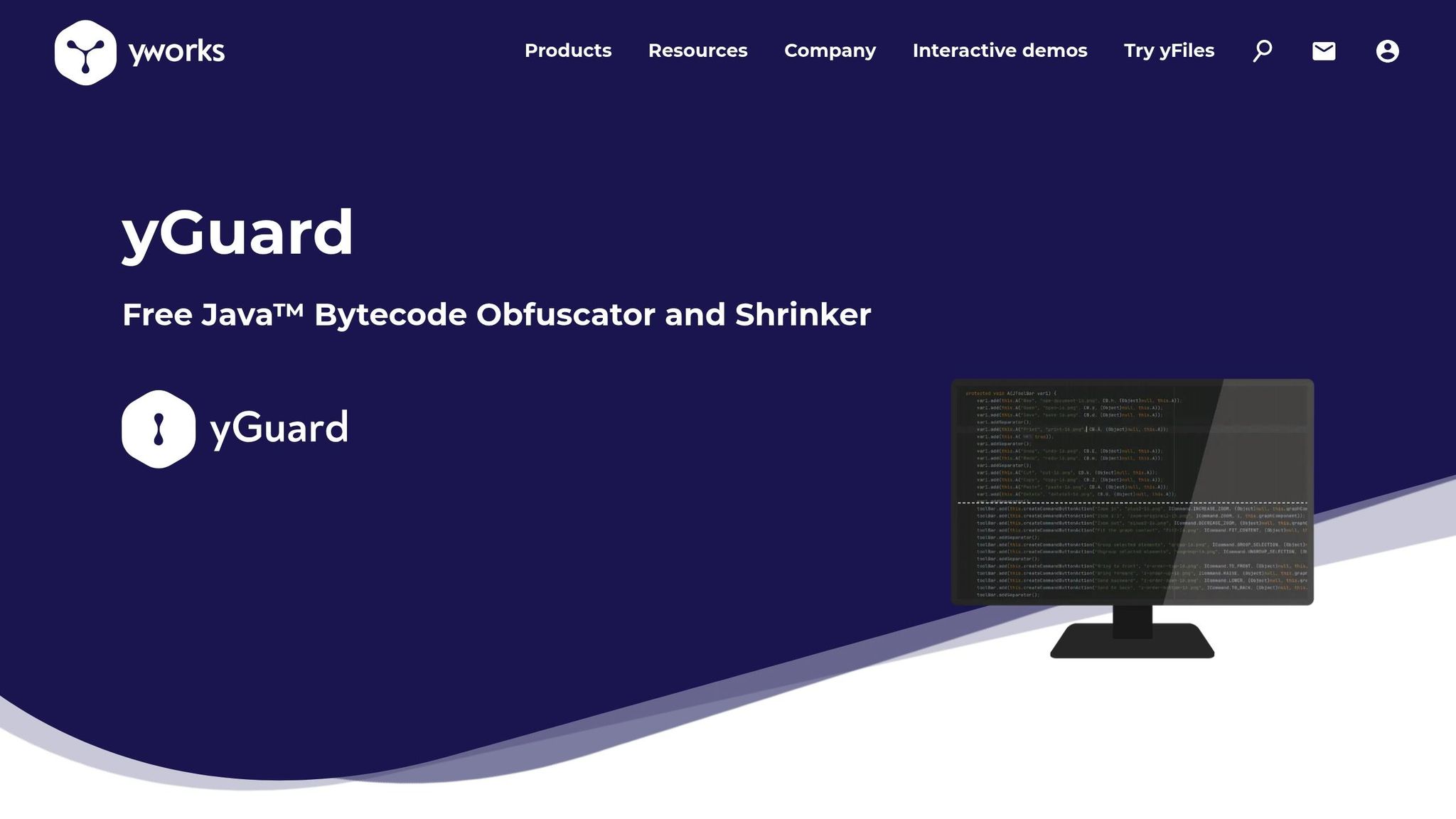
yGuard is a Java bytecode obfuscator and shrinker developed by yWorks, designed to protect compiled Java applications. Unlike tools that focus exclusively on Android APKs, yGuard targets Java bytecode across multiple platforms, making it a flexible option for Java developers looking to secure their code.
Open-Source or Proprietary
yGuard is licensed under the MIT license, reflecting yWorks' dedication to open-source principles. As the company explains:
"Because we want to give something back to the community! Open Source is an essential part of modern software development and helps us to create better software every day. We want to be part of that movement! That is why we made yGuard fully open source."
This open-source approach allows developers to access yGuard's source code on GitHub, providing the freedom to adapt it to specific requirements. The MIT license ensures that the tool remains accessible, removing the cost barriers typically associated with commercial obfuscation solutions.
Platform Support
yGuard is compatible with Windows, Linux, and macOS, and integrates seamlessly with Ant and Gradle. By working directly with Java bytecode, it can secure applications on any platform that supports the Java Virtual Machine (JVM). This cross-platform capability makes it especially useful for enterprise-level Java applications that operate in varied environments.
Primary Use Case
yGuard is designed for two main purposes:
- Name Obfuscation: It scrambles package, class, method, and field names into random, meaningless characters, making reverse-engineering much more difficult.
"yGuard protects your .class files from reverse engineering by replacing package, class, method, and field names with inexpressive characters."
- Code Shrinking: yGuard analyzes bytecode to identify and eliminate unused or redundant code. This process not only removes dead code but also contributes to reducing the size of the final application, improving efficiency.
Performance Impact
One of yGuard's standout features is its ability to reduce the size of JAR files, which directly improves application startup times. By removing unused bytecode, it minimizes memory usage and enhances performance.
"yGuard drastically reduces the size of the input Jar files if your application does not use all of the contained bytecode. This reduces the startup time of your application."
Despite its robust obfuscation and shrinking capabilities, yGuard introduces minimal overhead during the build process. Since it works with compiled bytecode rather than source code, it integrates smoothly into existing development pipelines without requiring significant adjustments.
Next, let's explore how JShrink approaches Java application optimization.
5. JShrink
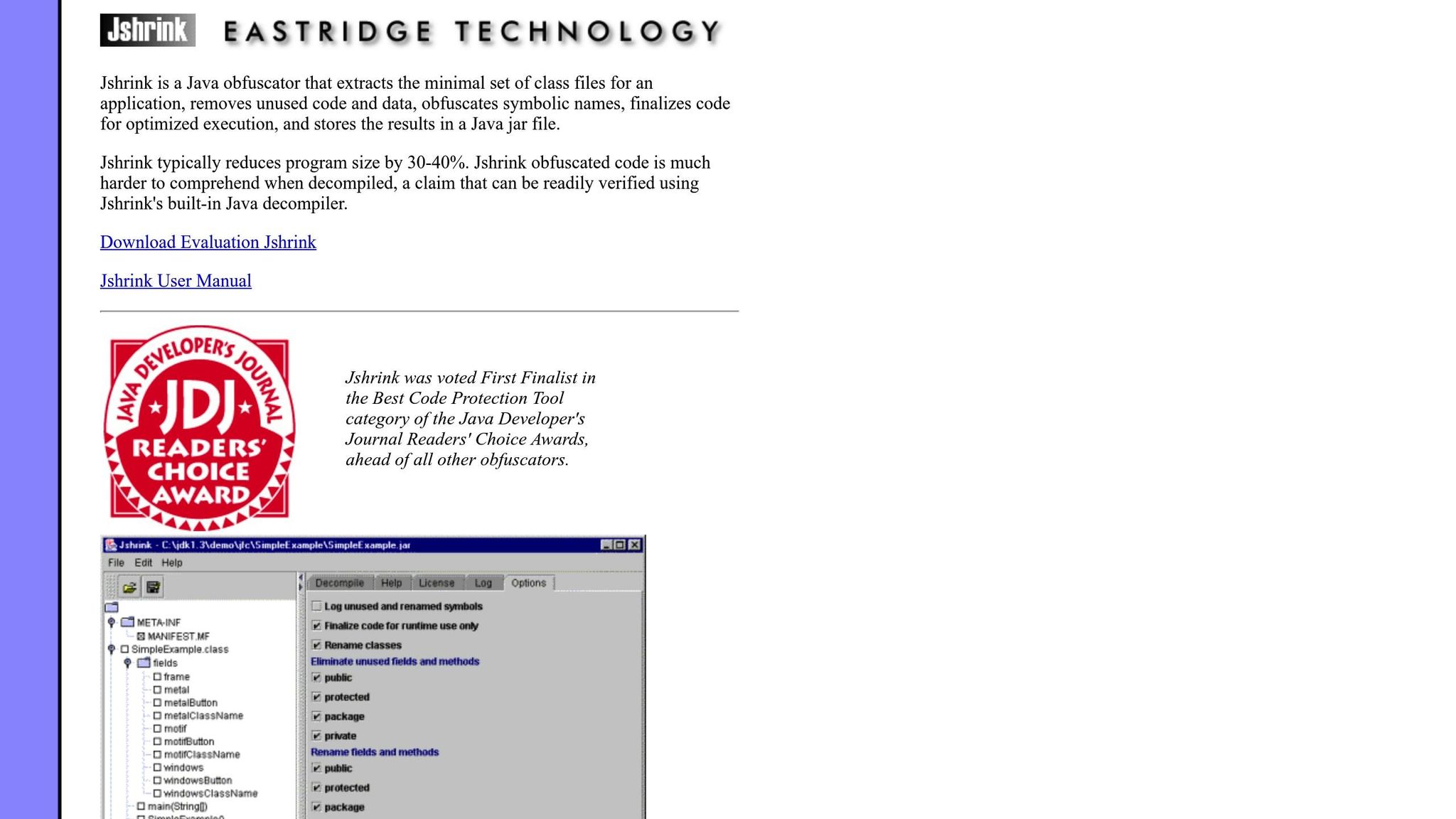
JShrink is a tool designed to optimize Java bytecode, but it comes with minimal documentation, making it a bit of a mystery for developers.
Overview
One of its key techniques, dead code elimination, is mentioned but not thoroughly explained in available resources. This lack of detail means developers need to dig deeper to understand its functionality and determine if it aligns with their requirements.
Considerations
Given the sparse documentation, it's crucial for users to carefully evaluate JShrink's licensing terms, compatibility with their platforms, and the potential impact on performance before deciding to use it in production. For those exploring alternatives, MidgetPack offers a more targeted solution for binary compression.
6. MidgetPack
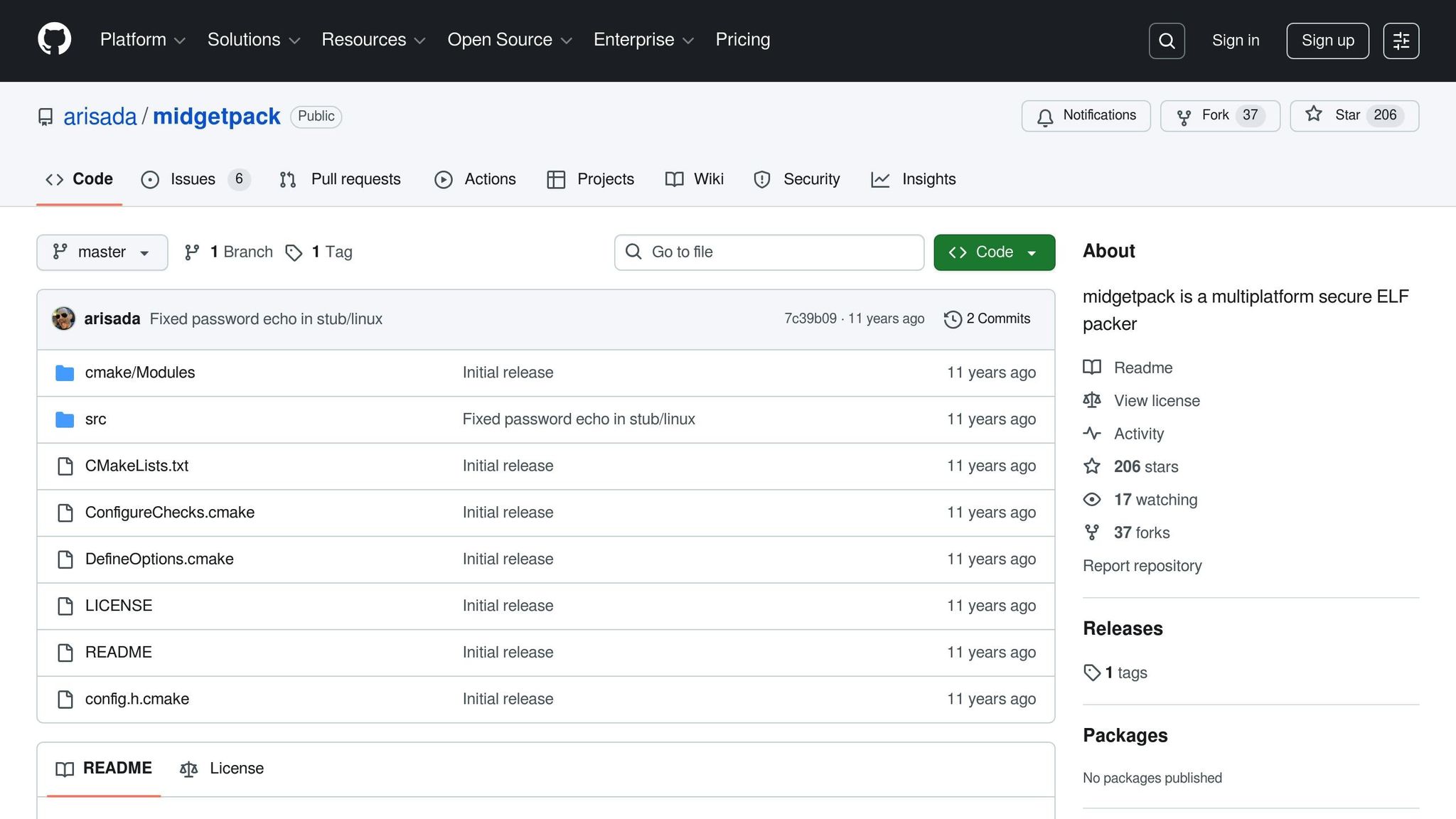
MidgetPack is an open-source binary packer tailored for ELF files. It provides developers with a straightforward way to secure their executables using compression and obfuscation techniques.
Platform Support
MidgetPack is compatible with Linux and FreeBSD, supporting x86-32, x86-64, and ARM architectures. However, since it focuses exclusively on ELF binaries, it doesn’t work with Windows or Android files. Windows relies on PE files, while Android applications typically use APKs containing DEX files.
Open-Source Model
As an open-source tool, MidgetPack’s source code is fully accessible on GitHub, allowing developers to review, modify, and adapt it as needed. This transparency is a key advantage. Lindsey Miller from Nexcess highlights this by stating:
"Its open-source model provides complete code access and modifiability." - Lindsey Miller, Nexcess
Primary Use Case
MidgetPack is specifically designed for secure binary packing rather than traditional encryption. Its main functions include compressing and obfuscating ELF binaries to reduce file size and make reverse engineering more difficult. These features are especially valuable for embedded systems, IoT devices, and server applications where both security and storage efficiency are critical.
Performance Impact
Thanks to its open-source nature, developers can fine-tune MidgetPack’s performance to meet their specific needs. The community-driven development model ensures that updates and fixes can be implemented quickly. As open-source advocate Jason Gibson puts it:
"If it's in enough demand it will be forked and never die for all purposes." - Jason Gibson, Open source user and advocate
Next, we’ll take a closer look at Burneye as another binary packing solution.
7. Burneye
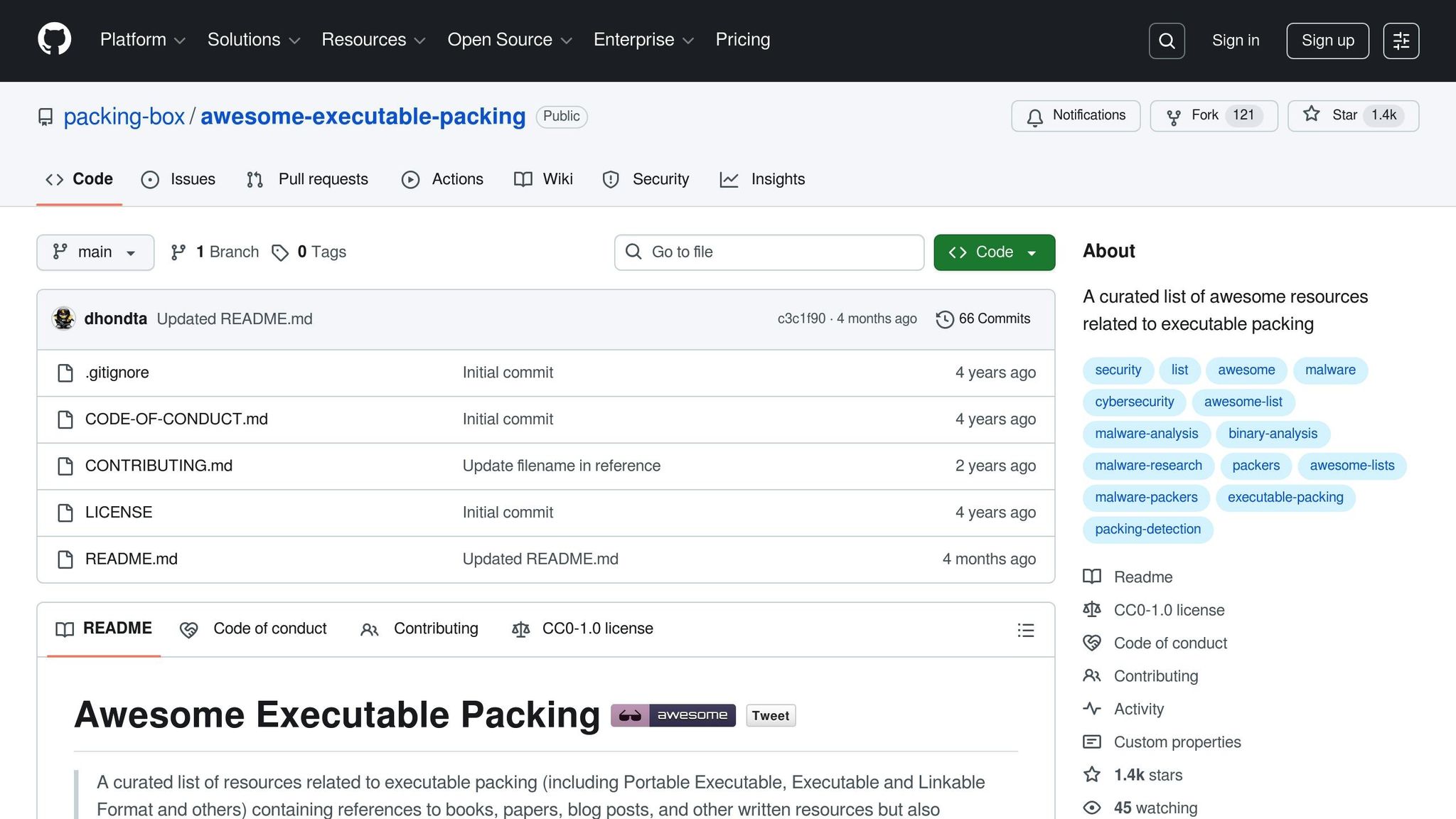
Burneye is a well-known binary packing tool, but information about its features, compatibility, and overall performance is quite limited. This lack of detailed documentation means users should thoroughly test it to ensure it meets their specific requirements. In the following sections, we'll explore tools that provide more comprehensive documentation and support.
sbb-itb-8abf120
8. VeraCrypt
VeraCrypt is a powerful tool designed to safeguard your data through encryption rather than compressing files. This free, open-source disk encryption software creates secure, encrypted volumes that protect sensitive information from unauthorized access. Let’s break down what makes VeraCrypt stand out in the world of encryption.
Primary Use Case (Binary Packing or Encryption)
VeraCrypt is focused entirely on encryption, not on binary packing. It excels in real-time encryption of files, partitions, or even entire drives. This ensures your data remains confidential and intact. The best part? When you access files stored in a VeraCrypt volume, the software decrypts them instantly, allowing seamless interaction without compromising security.
Platform Support
VeraCrypt offers broad compatibility across major platforms. It supports:
- Windows 10 and newer versions, as well as Windows Server 2016-2019
- macOS 12 and later
- Linux and FreeBSD
This cross-platform functionality makes it easy to use encrypted volumes across different operating systems.
However, there’s a catch: VeraCrypt doesn’t officially support mobile platforms. It lacks official apps for Android and iOS, and using unofficial mobile apps is strongly discouraged due to the risk of data loss or compromise. This limitation makes it less practical for users who need encryption on mobile devices.
Open-Source or Proprietary
VeraCrypt’s open-source nature is one of its key strengths. It allows security experts to audit the software’s encryption methods, ensuring transparency and reliability. This openness has helped VeraCrypt build a solid reputation as a trustworthy encryption solution.
Performance Impact
VeraCrypt is designed for efficient performance. Thanks to real-time processing and hardware acceleration via AES-NI, it delivers near-native data speeds. By using parallelization and pipelining techniques, it ensures that encrypted data can be read and written almost as quickly as unencrypted data.
For systems with processors that support AES-NI, performance gets an extra boost. VeraCrypt leverages these optimized hardware instructions to speed up encryption and decryption processes, making it a highly efficient choice for securing your data.
9. BitLocker
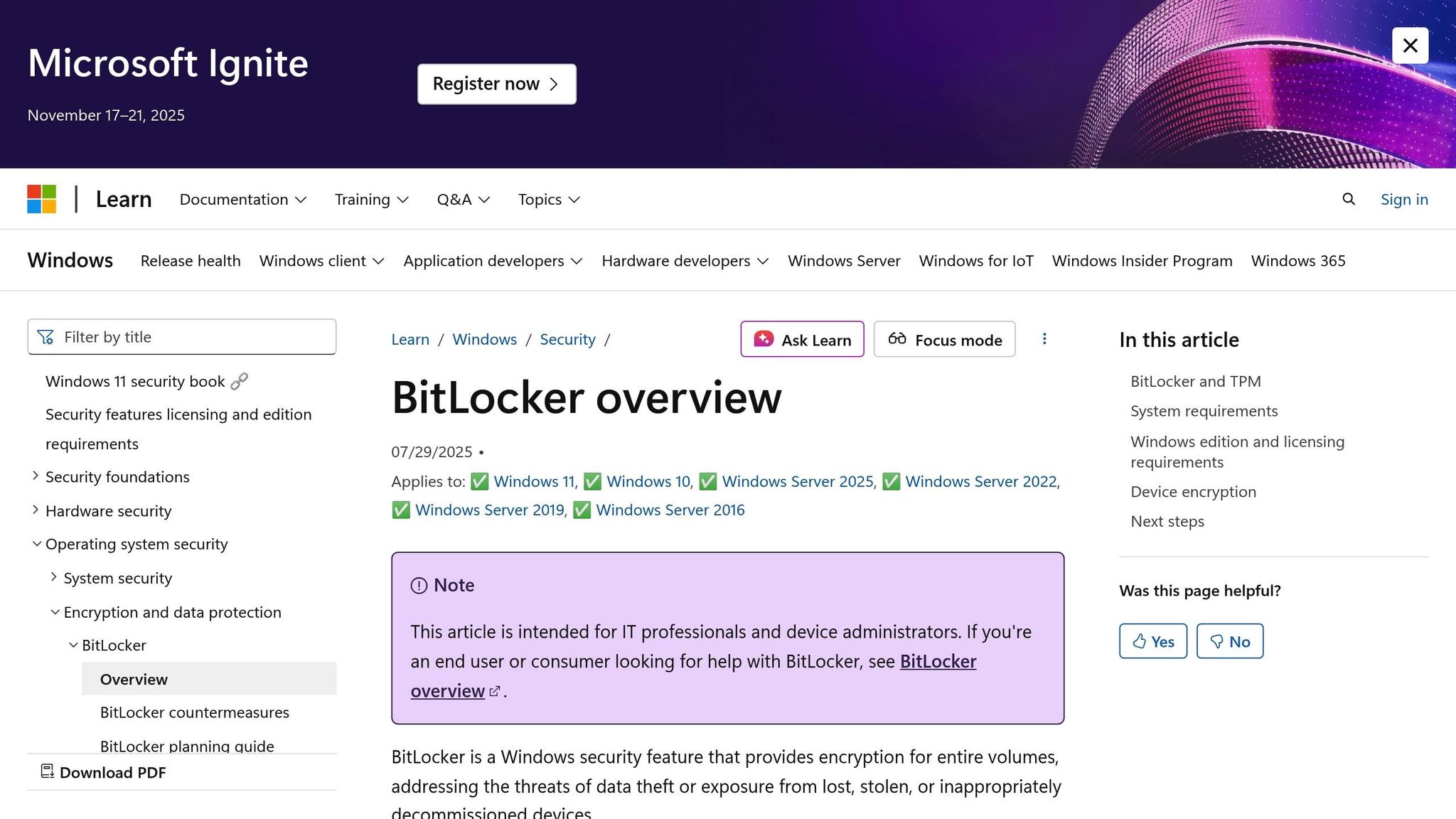
BitLocker is Microsoft's built-in encryption tool designed specifically for Windows users. This solution comes pre-installed on supported versions of Windows and focuses on full-disk encryption, offering a straightforward way to secure your data without needing third-party software. It's designed to safeguard entire drives, making it a practical choice for users looking for strong protection integrated directly into their operating system.
Primary Use Case: Full-Disk Encryption
BitLocker is all about encrypting entire drives. Whether it's your system drive, a secondary hard drive, or a USB stick, BitLocker ensures everything - from the operating system and system files to personal data - is encrypted. Once you authenticate, the system drive is automatically decrypted, while additional drives can either unlock automatically or require separate credentials, such as passwords or smart cards.
This approach differs from file-level encryption tools, as BitLocker focuses on protecting the entire disk rather than individual files or folders. It's especially useful for securing sensitive data on laptops and portable drives.
Platform Support
BitLocker is exclusive to Windows and is available on:
- Windows 10: Pro, Enterprise, and Education editions
- Windows 11: Pro, Enterprise, and Education editions
- Windows Server: 2016, 2019, and 2022
It’s important to note that BitLocker is not supported on Windows Home editions. Additionally, it doesn’t work on macOS, Linux, Android, or iOS. However, BitLocker To Go allows you to encrypt USB drives and external storage, which can then be accessed in read-only mode on other Windows systems, even those without BitLocker.
Open-Source or Proprietary
BitLocker is proprietary software developed and managed solely by Microsoft. Unlike open-source encryption tools, where the code is available for public scrutiny, BitLocker relies on Microsoft’s internal security practices. While Microsoft has a strong reputation in enterprise security, this closed-source nature means users must trust the company’s implementation without the transparency offered by open-source alternatives.
This distinction is important for those who prioritize independent audits or prefer open-source tools for their transparency and community-driven improvements.
Performance Impact
When it comes to performance, BitLocker is designed to operate efficiently with minimal impact on modern systems. Devices equipped with TPM (Trusted Platform Module) chips handle encryption and decryption processes seamlessly in the background, so most users won’t notice any slowdown during regular tasks.
On systems with AES-NI hardware acceleration, BitLocker performs even better. While the initial encryption process can take a few hours - typically 2 to 4 hours for a 500GB drive - you can continue using your computer during this time. After the initial setup, day-to-day performance remains smooth, making BitLocker a reliable option for securing your data without compromising usability.
10. AxCrypt Premium

AxCrypt Premium offers a straightforward solution for secure file-level encryption, making it an excellent choice for personal users and small businesses. Its simplicity ensures reliable protection without the added complexity of full-disk encryption.
Primary Use Case: File-Level Encryption
This tool focuses on encrypting individual files using AES-256 encryption and supports Multi-Factor Authentication for added security. Compared to the free version, which uses AES-128, the Premium version provides stronger encryption.
Open-Source or Proprietary
AxCrypt Premium operates as a proprietary, subscription-based tool. Its closed-source nature means users rely on vendor-provided features, but it comes with the assurance of no backdoors.
Pricing
The subscription starts at $47 per year or $5 per month. For businesses, a plan is available at $12 per user per month. Subscribers also benefit from regular updates and dedicated support.
Next, let’s explore how NordLocker handles file encryption.
11. NordLocker
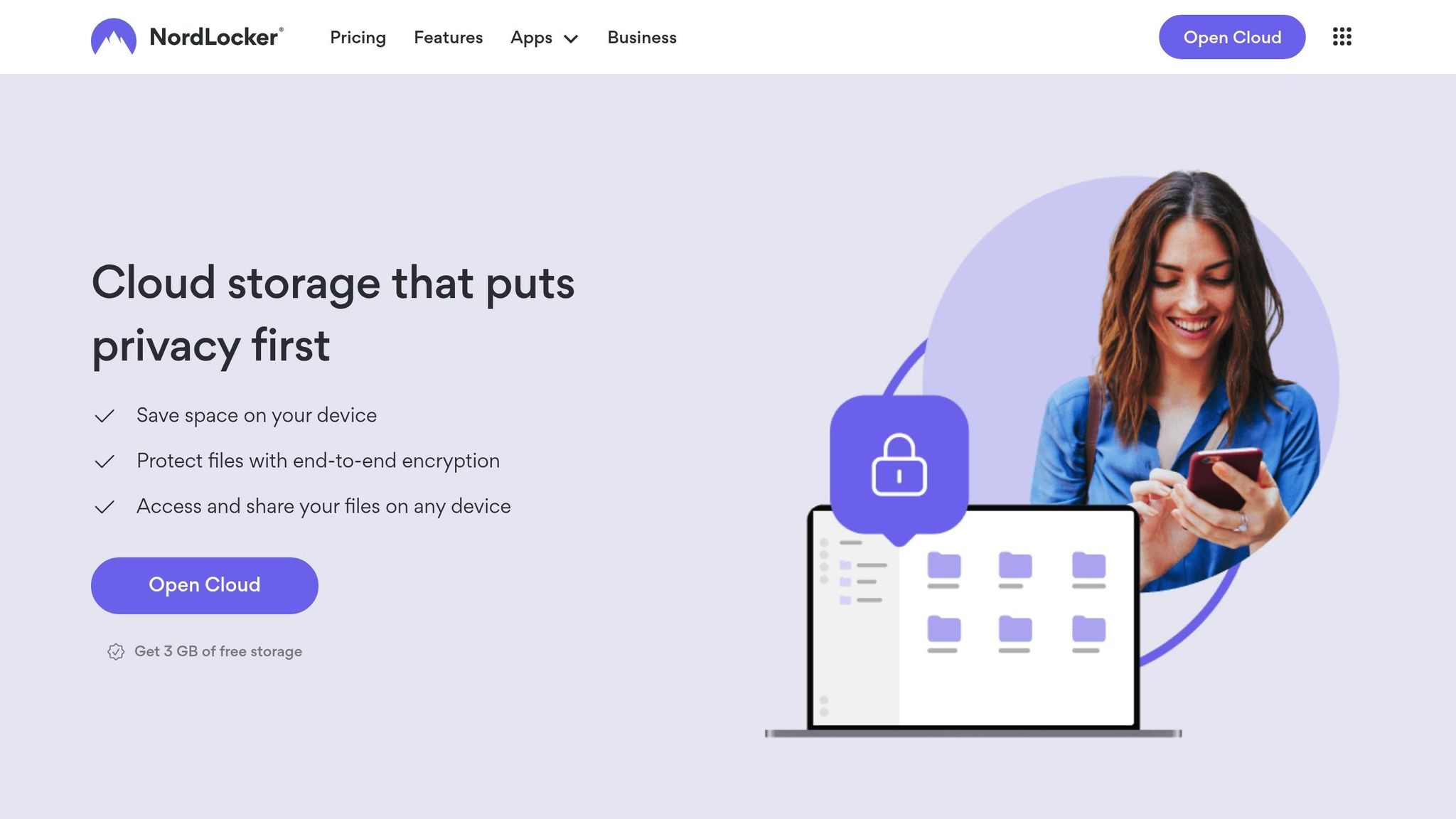
NordLocker is a tool designed to keep your documents, photos, and other files safe by encrypting them and storing them in secure digital lockers. These lockers act as dedicated spaces where your files are protected and easily organized.
Platform Support
NordLocker is compatible with multiple platforms, ensuring you can access your encrypted files wherever you need them.
Open-Source or Proprietary
NordLocker operates as a proprietary, subscription-based service. Up next, let’s take a look at how 7-Zip approaches file compression and encryption.
12. 7-Zip
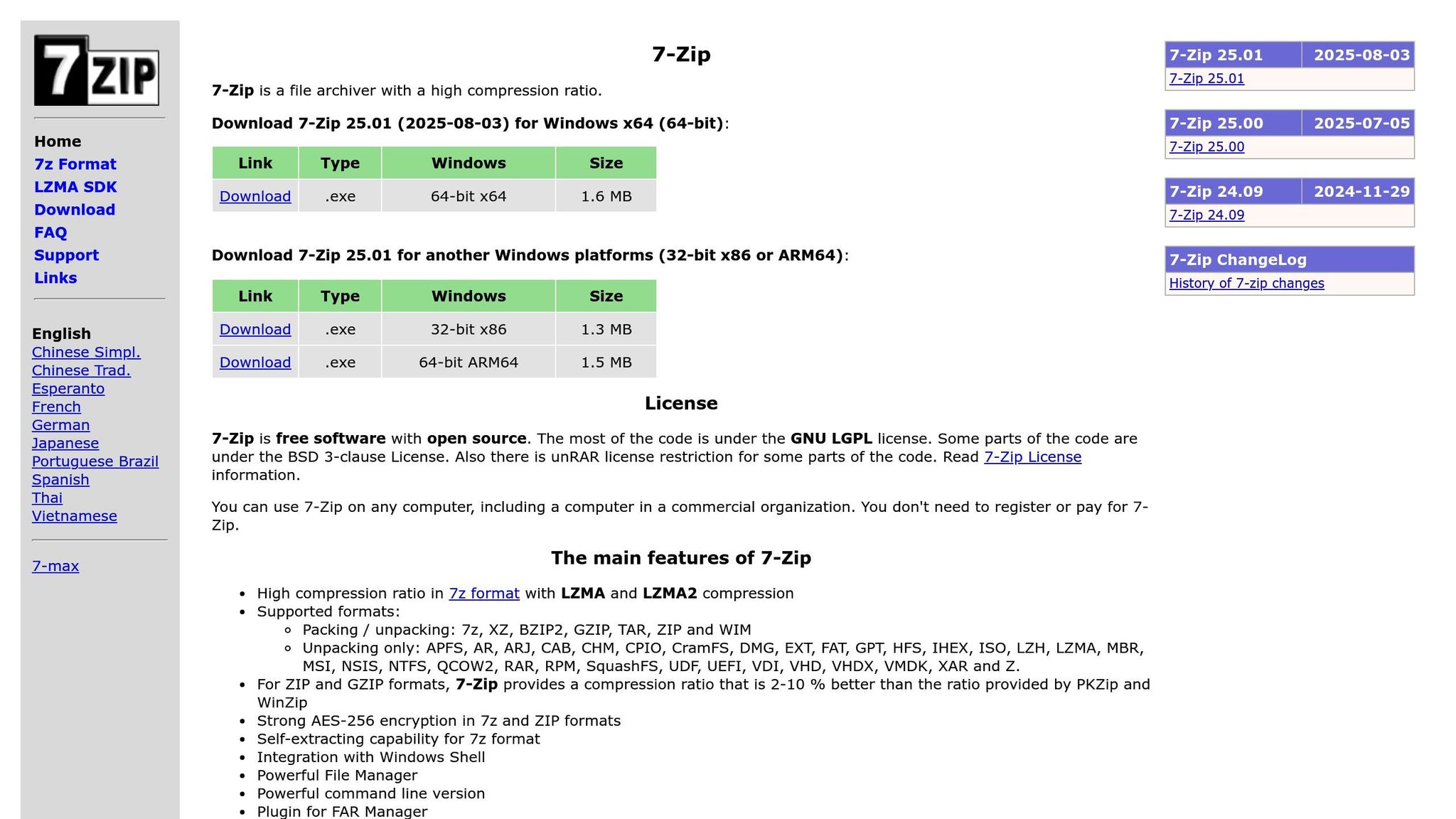
7-Zip is a free, open-source file archiver that combines efficient binary packing with AES-256 encryption - all without any licensing fees. It’s widely recognized for its ability to compress files into smaller sizes, making it a go-to tool for storage and distribution needs.
Platform Support
7-Zip is designed primarily for Windows, offering a full graphical interface for ease of use. For Linux and macOS users, command-line versions are available via the p7zip port, ensuring cross-platform functionality.
Open-Source or Proprietary
This tool operates under the GNU LGPL license, meaning its source code is freely available for review and modification, ensuring transparency and community-driven development.
Primary Use Case
7-Zip stands out for its advanced compression algorithms, particularly the LZMA and LZMA2 methods, which are excellent for compressing executable files and large datasets. Additionally, it provides AES-256 encryption in CBC mode, offering strong security for sensitive archived files.
Performance Impact
When set to maximum compression levels, 7-Zip delivers impressive results in reducing file sizes. However, this comes at the cost of increased processing time and higher memory usage. On the encryption side, the performance impact is minimal, making it a practical choice for secure file archiving.
Tool Comparison Table
Choose the best tool for your needs by examining the key characteristics below.
| Tool | Platform Support | Primary Use Case | License Type | Performance Impact |
|---|---|---|---|---|
| ProGuard | Android, Java applications | Code obfuscation and shrinking for Android apps | Open-source (GPL) | Low to moderate; reduces APK size effectively |
| R8 | Android Studio, Gradle builds | Default Android code shrinker and obfuscator | Open-source (Apache 2.0) | Minimal; integrates seamlessly into builds |
| AndResGuard | Android applications | Resource obfuscation and compression | Open-source (Apache 2.0) | Low; optimizes app resources |
| yGuard | Java applications | Bytecode obfuscation for Java programs | Open-source (LGPL) | Moderate; depends on obfuscation level |
| JShrink | Java applications | Dead code elimination and optimization | Open-source (MIT) | Low; improves runtime performance |
| MidgetPack | Linux, FreeBSD | Executable compression and packing | Open-source | High; may slow down startup times |
| Burneye | Linux ELF binaries | Anti-debugging and binary protection | Open-source | Moderate; adds runtime protection overhead |
| VeraCrypt | Windows, macOS, Linux | Full disk and file encryption | Open-source (Apache 2.0) | Moderate; slight system performance impact |
| BitLocker | Windows (Pro/Enterprise) | Windows system drive encryption | Proprietary (Microsoft) | Low; benefits from hardware acceleration |
| AxCrypt Premium | Windows, macOS, Android, iOS | File-level encryption with cloud integration | Proprietary | Minimal; offers transparent file access |
| NordLocker | Windows, macOS, Android, iOS | Cloud-based file encryption and sharing | Proprietary | Low; optimized for cloud sync |
| 7-Zip | Windows, Linux, macOS | File compression with AES-256 encryption | Open-source (LGPL) | Variable; high compression may need more resources |
This table outlines the strengths and trade-offs of each tool, helping you make an informed choice based on your specific requirements. Each tool is designed to enhance security, whether through encryption, compression, or obfuscation, which is increasingly vital in today's tech landscape.
For developers prioritizing transparency, open-source options like ProGuard, R8, and VeraCrypt allow for code audits and community contributions. On the other hand, proprietary tools such as BitLocker and NordLocker provide user-friendly integration and dedicated support, making them ideal for those who value convenience.
If your focus is on mobile development, tools like R8 and AndResGuard are tailored for Android and integrate directly into the build process. For desktop applications, consider packers like MidgetPack for compression or encryption tools such as VeraCrypt for robust protection.
Keep in mind that tools like 7-Zip and MidgetPack excel at compression but may require additional processing power, especially with high settings. Encryption tools, particularly those leveraging hardware acceleration, generally have a smaller impact on performance. By understanding these distinctions, you can align your tool choices with your app's security and performance needs.
Conclusion
Choosing the right binary packing and encryption tools is all about balancing protection, performance, and practicality. Each of the twelve tools we've discussed has its own strengths, whether it's ProGuard's ability to optimize Android apps or VeraCrypt's focus on disk encryption.
The decision starts with identifying your main goals. For instance, Android developers might lean toward tools like R8 or AndResGuard, while desktop developers could find MidgetPack or 7-Zip better suited for compression and encryption. On the other hand, organizations managing sensitive data across various platforms often turn to all-encompassing solutions like BitLocker or NordLocker.
Performance is another key factor. Tools like MidgetPack can shrink file sizes but might slow down startup times, whereas hardware-accelerated options like BitLocker provide strong data protection without sacrificing speed. Striking the right balance is crucial to protecting your applications while maintaining efficiency. These trade-offs underline the importance of carefully integrating the right tools for your specific needs.
Proper implementation goes beyond just picking a tool - it requires detailed configuration, thorough testing, and ongoing maintenance. Expert guidance can make all the difference in navigating these challenges.
At Zee Palm, our team of 10+ seasoned developers brings over a decade of experience in delivering secure solutions across industries like AI, healthcare, blockchain, and IoT. With a track record of 100+ successfully completed projects for 70+ happy clients, we have a deep understanding of integrating binary packing and encryption tools into a variety of platforms. From selecting the best tools to ensuring seamless integration without compromising performance, we cover every step of the process.
Whether you're building a healthcare app that needs to meet HIPAA standards, developing a Web3 platform with advanced security requirements, or creating an IoT solution that demands lightweight yet strong protection, the right tools combined with expert implementation can deliver secure, high-performance applications. Let experience and precision guide your way.
FAQs
What should I consider when selecting a tool for binary packing and encryption for my project?
When selecting a tool for binary packing and encryption, it’s crucial to align your choice with the specific needs of your project. Think about factors like security, performance, and compatibility to guide your decision.
For encryption, focus on the strength of the algorithm, the key length, and whether your project requires symmetric or asymmetric encryption. Keep in mind that while stronger encryption enhances security, it often comes with increased processing demands.
When it comes to binary packing, look for tools that can reduce application size and improve performance without sacrificing support for your target platforms and data types. Consider how user-friendly the tool is, whether it integrates smoothly with your current systems, and whether it meets your security standards. Matching the tool’s capabilities to your project’s objectives will set the stage for a successful implementation.
What are the key differences between open-source and proprietary encryption tools, and how do they affect security and usability?
Open-source encryption tools are often appreciated for their openness because their code is available for anyone to examine. This openness invites community participation, enabling quicker detection of flaws and collaborative enhancements. That said, their effectiveness relies heavily on an active and engaged community, as well as regular updates to address potential issues.
In contrast, proprietary tools are built and maintained by private companies. These tools typically offer restricted access and rely on in-house security protocols. While this setup can build confidence in the company’s responsibility for security, it also means users can’t independently review the code. Deciding between open-source and proprietary options comes down to what matters most to you - whether it’s the openness and teamwork of a community-driven approach or the structured security and support provided by a dedicated vendor.
What factors affect the performance of binary packing and encryption tools, and how can I ensure strong security without slowing down my system?
The performance of binary packing and encryption tools often depends on the complexity of the encryption algorithm and the amount of data being processed. For instance, using advanced encryption methods like AES can lead to higher CPU usage, potentially slowing down systems that manage large datasets. Similarly, binary packing - which is used to compress or obfuscate code - can introduce additional overhead, affecting how quickly programs execute.
To strike the right balance between security and performance, consider a few strategies. Leverage hardware acceleration to make encryption tasks faster, choose lightweight packing techniques, and align security measures with your system's performance limits. This way, you can achieve strong protection without compromising system efficiency.




